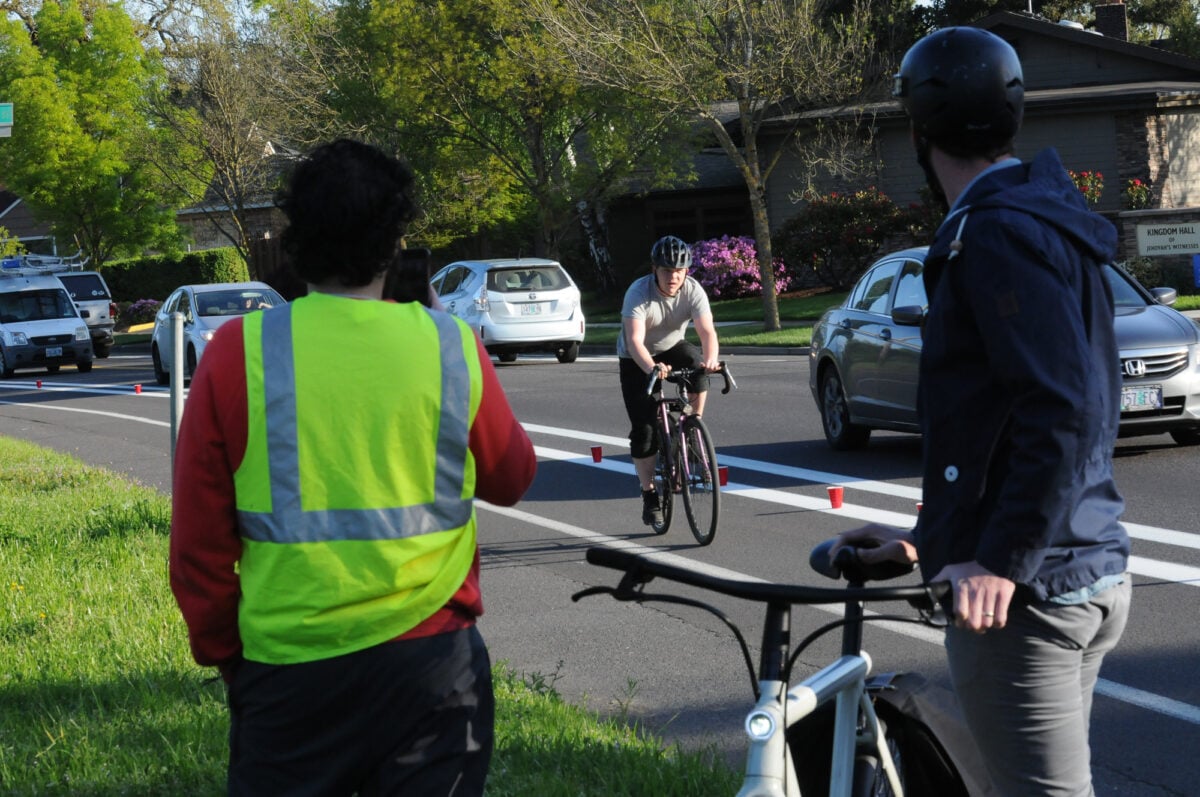
(Photos: J. Maus/BikePortland)
Paint is not protection.
That’s the message from people across America today who are taking part in the Red Cup Project. Inspired by the tragic death of Washington D.C. cycling advocate Dave Salovesh (@darsal), the red cups are a quick and cheap way to define space and show how relatively little effort it takes to create safer conditions for cycling.
“I want these cups to become planters, cement bollards — things that actually prevent people form swerving into bike lanes and force drivers to pay more attention.”
— Sam Balto, north Portland resident
North Portland residents Sam Balto and Reed Buterbaugh were out at on North Rosa Parks Way and Willamette Boulevard this morning with a jug of water and dozens of cups. They focused on two spots where people frequently drive their cars into bike lanes.
At the corner where those two streets converge, nearly every driver cuts into the bike lane (see photos below). As Balto and Andrews placed cups on the bike lane stripe, most people immediately slowed down and took the corner more cautiously to avoid running over them. But as you can see in our photos, the cups were often not enough.
As peoples’ car tires rolled over them, the crunching sound and water splattering onto the street made my hairs stand on end.
“There are people all over this country where mayors have pledged Vision Zero,” Balto said as he watched the tiny cups sacrifice their lives, “but they believe that paint is enough to protect people. It’s not.”
Asked what he wants the red cups to become in the future, Balto said, “I want these cups to become planters, cement bollards — things that actually prevent people form swerving into bike lanes and force drivers to pay more attention.”
Advertisement
“PBOT believes they’ve improved North Willamette. They haven’t. They’re not done here. They need to properly protect this. This is just paint, and paint is not protection.”
Balto’s comments are supported by recent research showing that paint-only cycling lanes are inadequate and often encourage drivers to pass with less caution.
On North Rosa Parks Way, it’s been nearly a year since PBOT created new protected bike lanes. But they never finished the job. The vast majority of the bikeway is still unprotected. In June of last year, PBOT said neighbors had objected to having more white plastic posts installed. We learned last week that cement curbs are on the way and should be installed by this summer.
Similar red cup demonstrations are taking place today in New York City, Seattle, Michigan, Austin, Washington D.C., Boston, and many other cities. Follow the #RedCupProject hashtag on Twitter for all the action.
UPDATE, 1:17 pm: Just saw on-board video of the Rosa Parks/Willamette pinch-point from reader @harv_mushman (via Instagram):
— Jonathan Maus: (503) 706-8804, @jonathan_maus on Twitter and jonathan@bikeportland.org
Never miss a story. Sign-up for the daily BP Headlines email.
BikePortland needs your support.



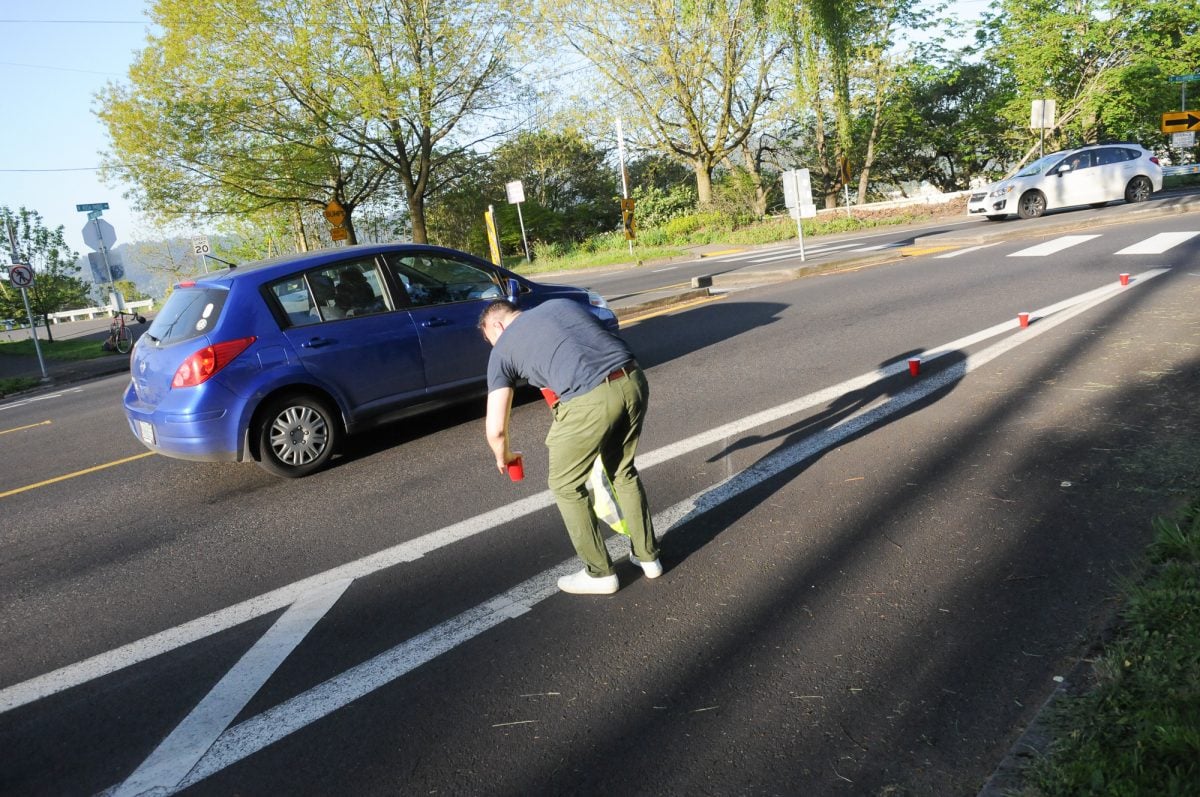
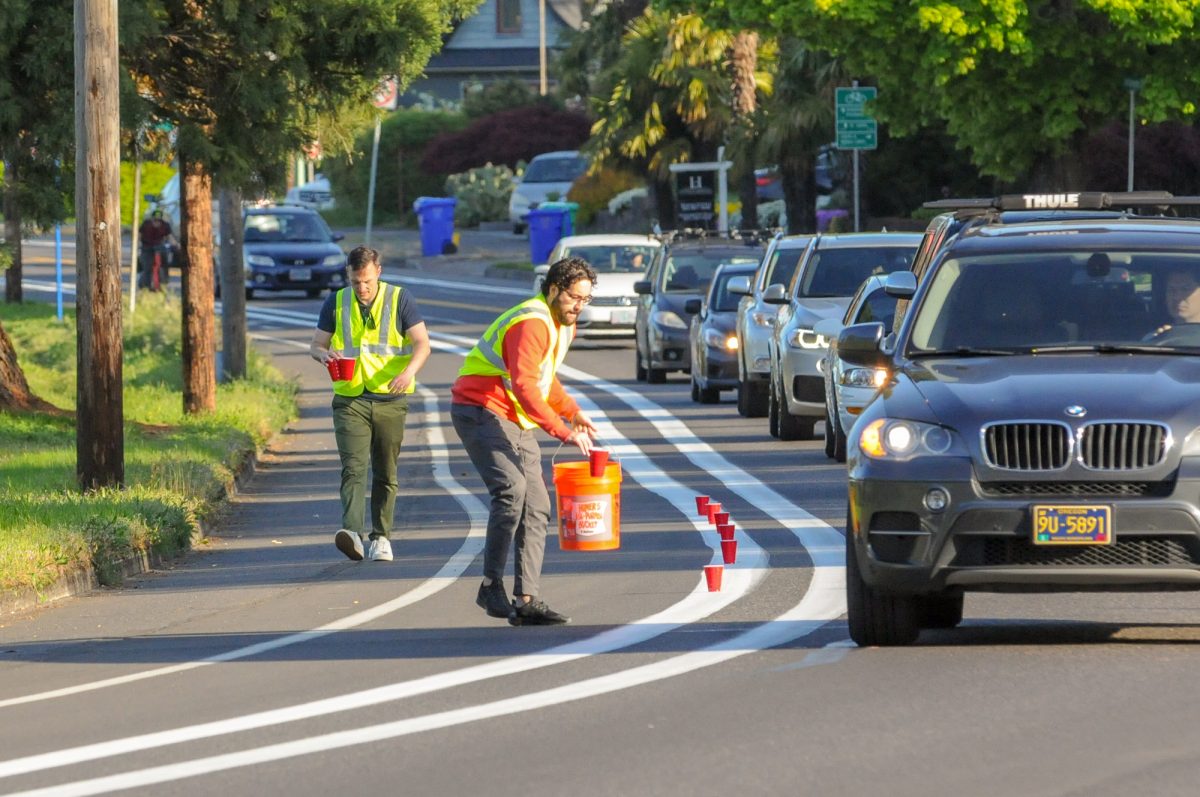
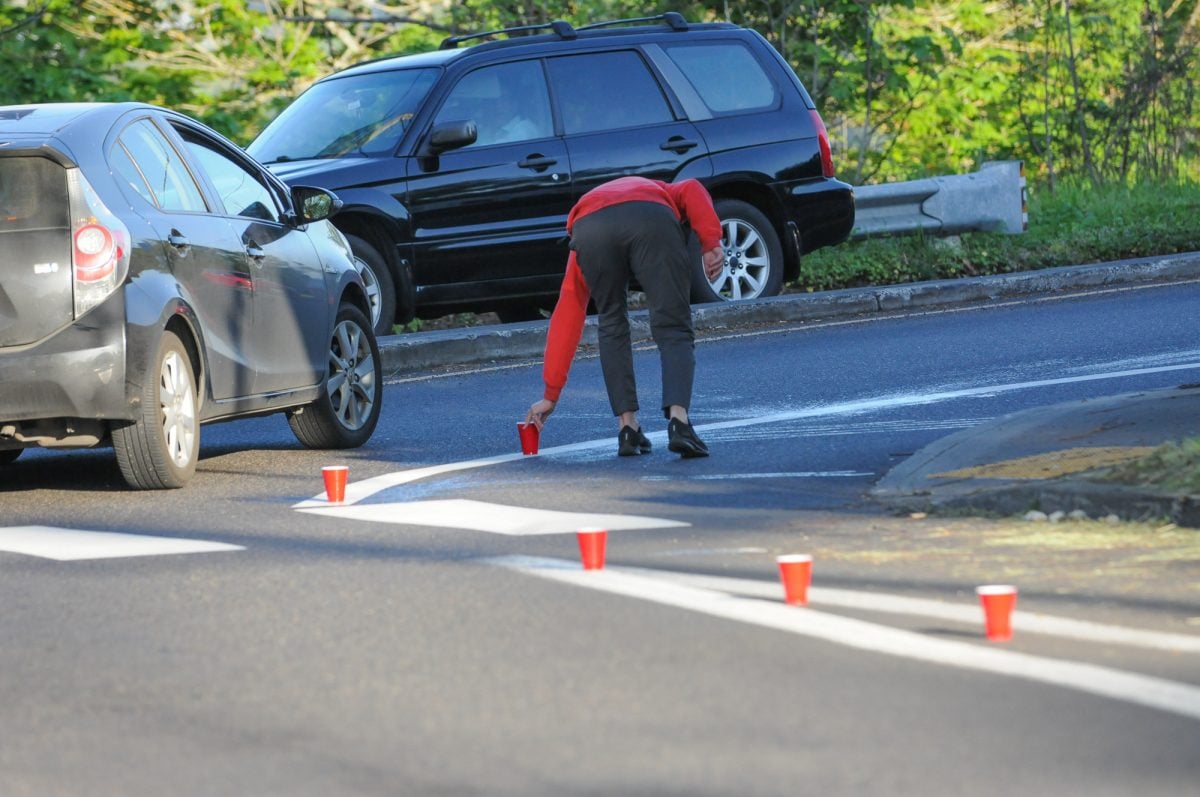
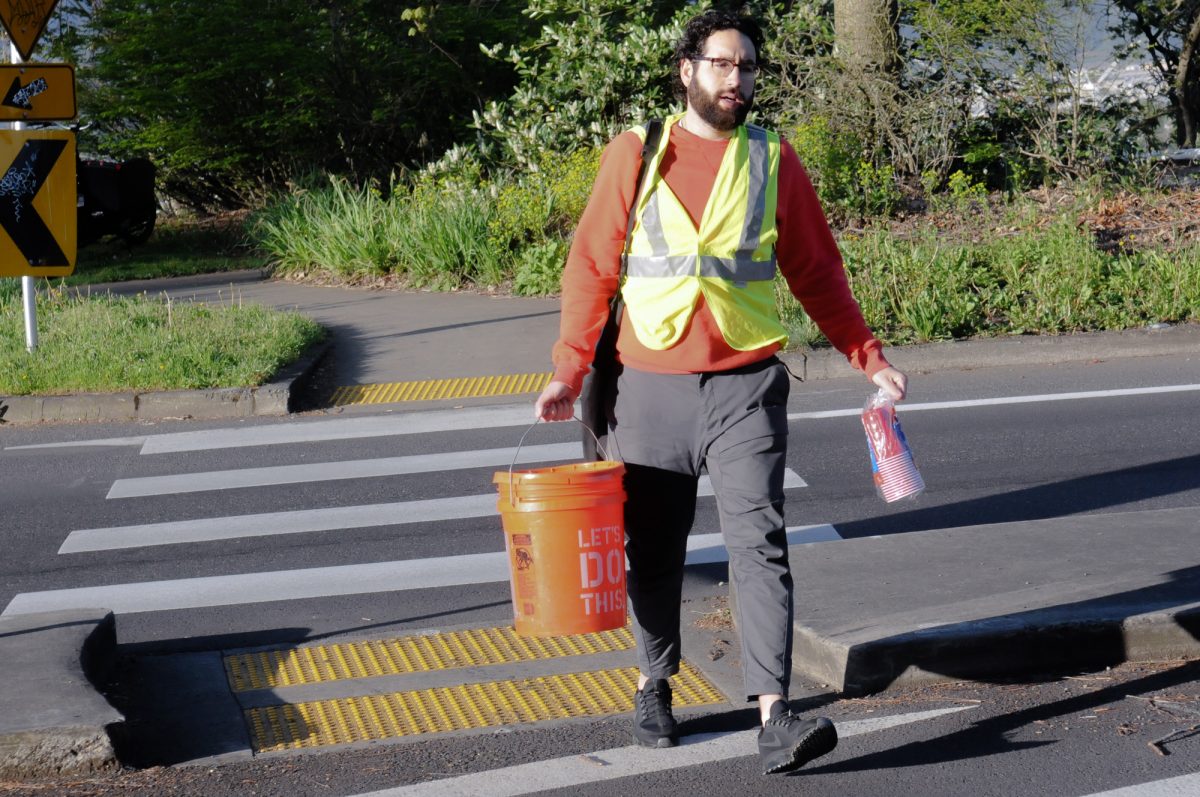
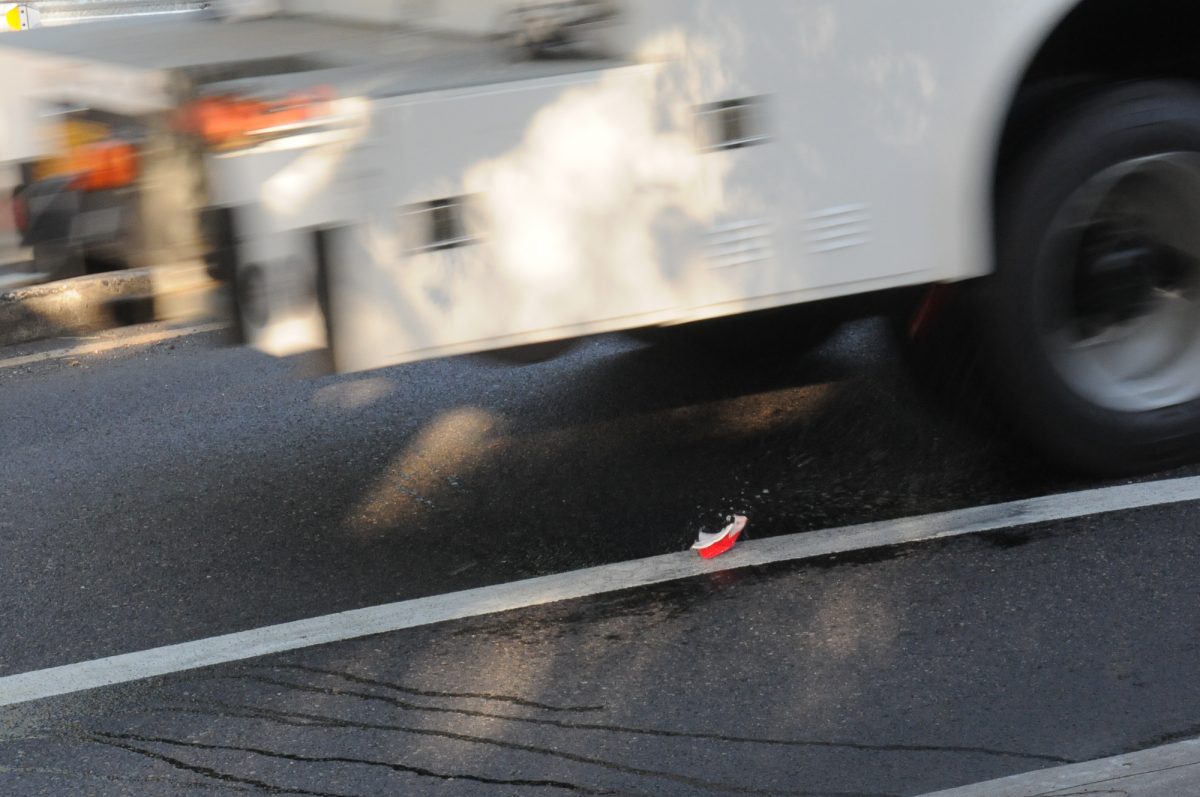
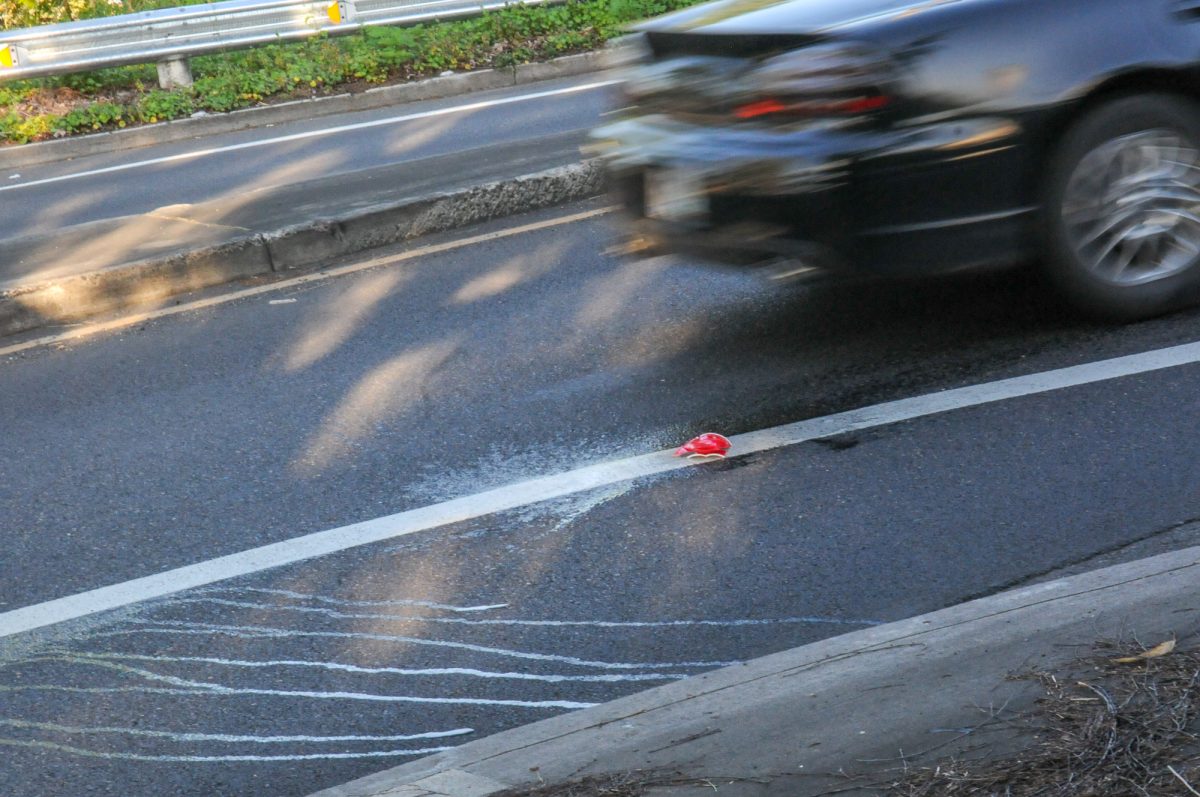
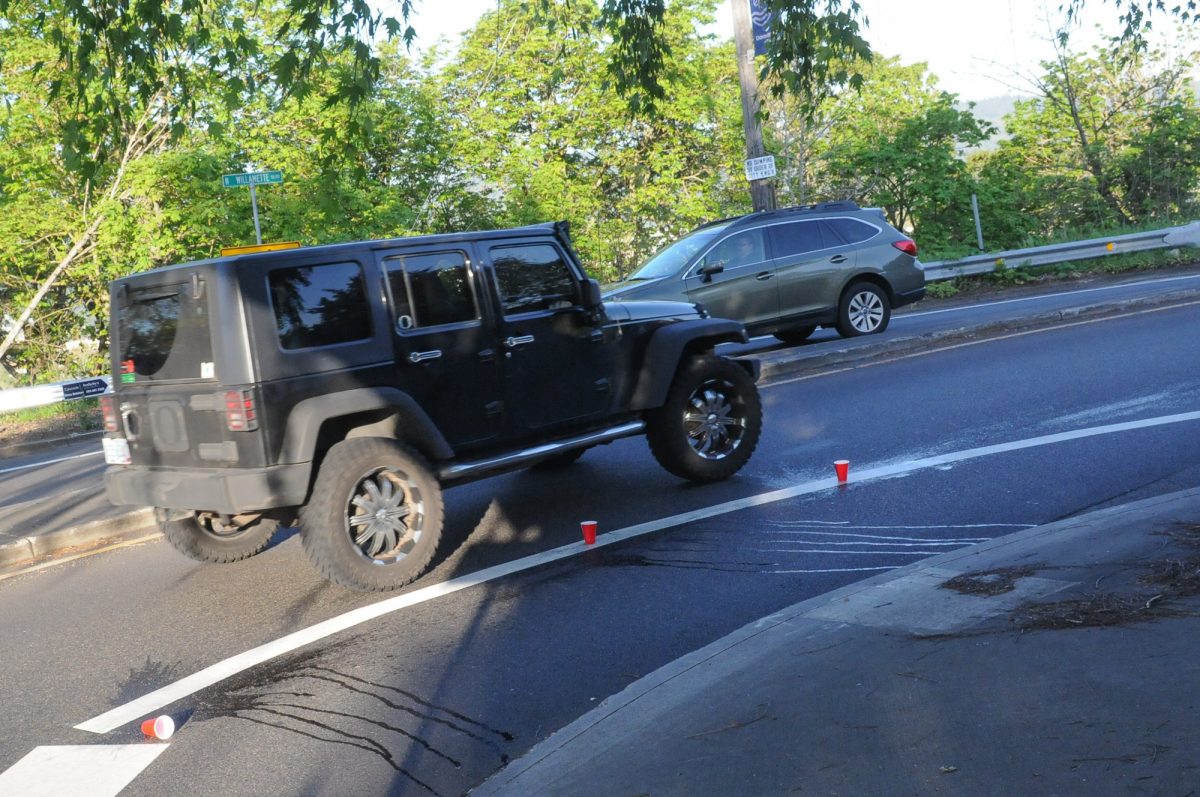

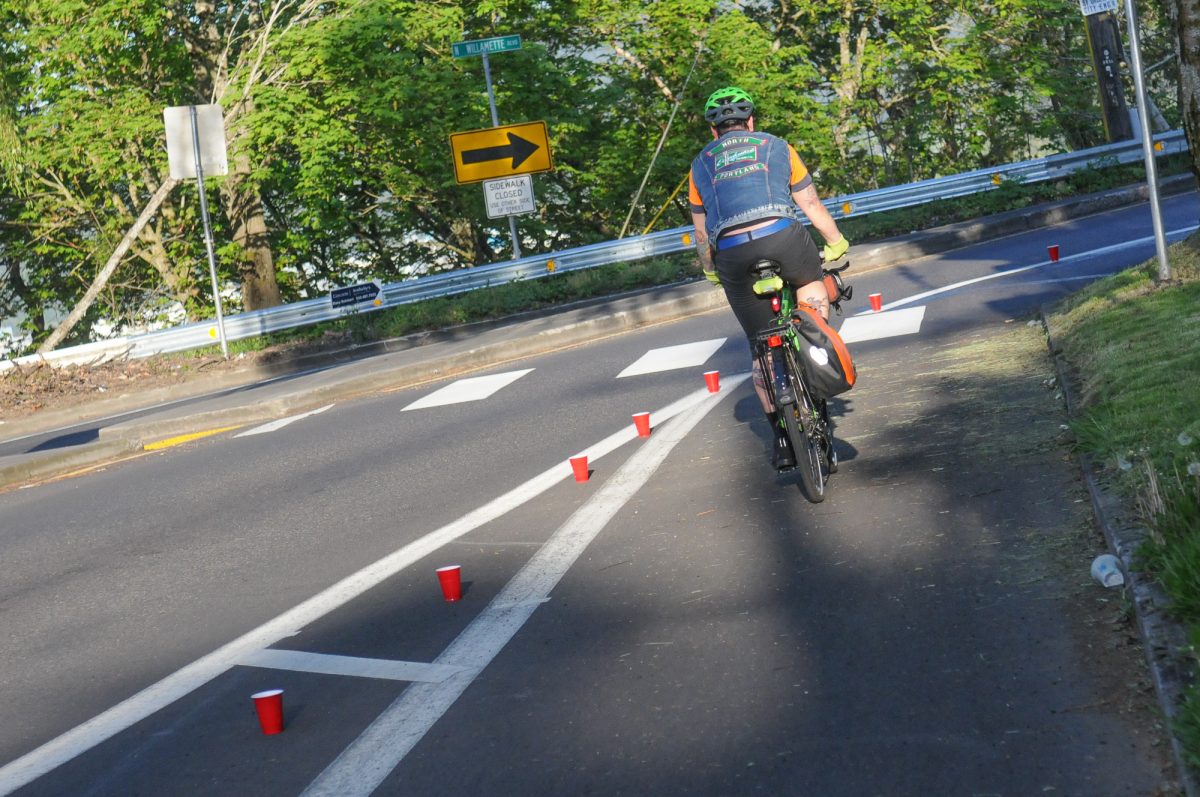
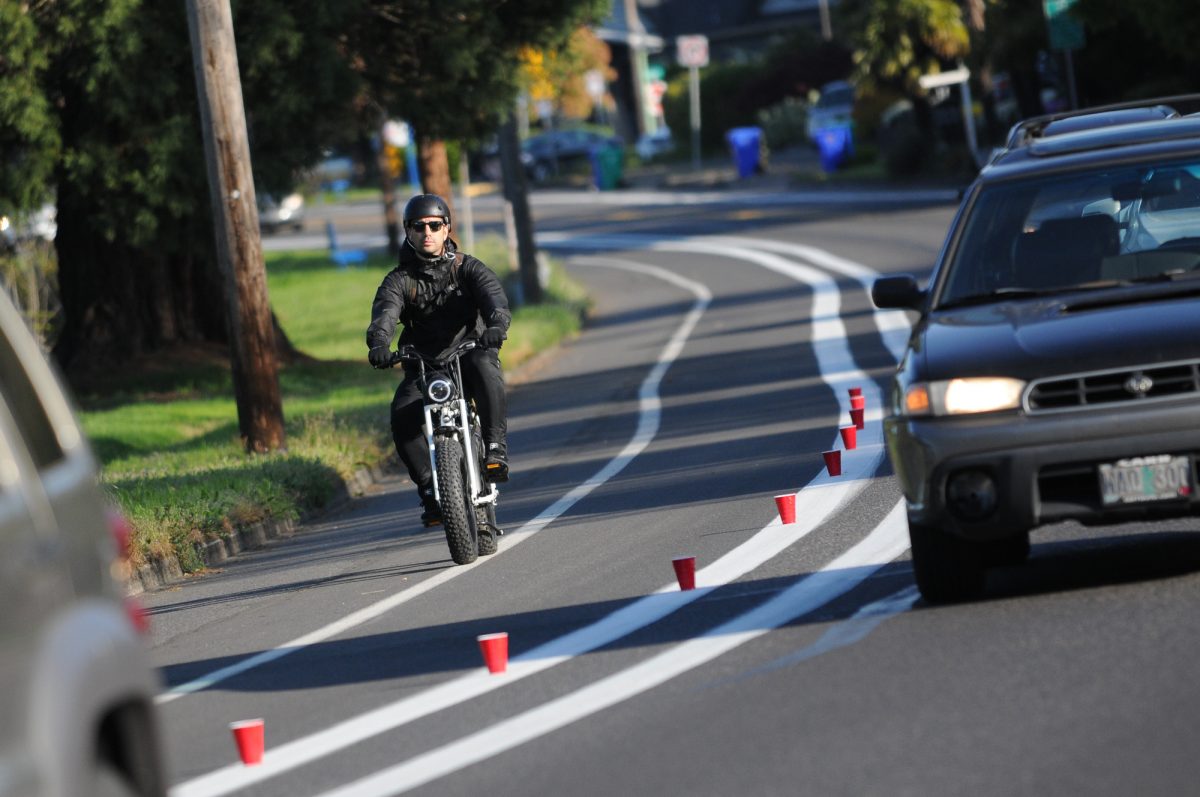



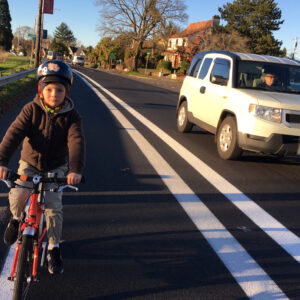
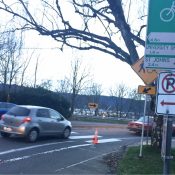
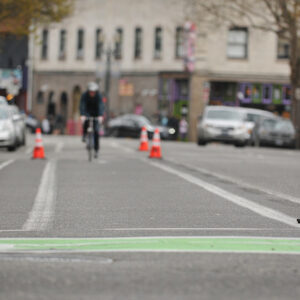

Thanks for reading.
BikePortland has served this community with independent community journalism since 2005. We rely on subscriptions from readers like you to survive. Your financial support is vital in keeping this valuable resource alive and well.
Please subscribe today to strengthen and expand our work.
I wonder if sometime in the future people will get frustrated with the effectiveness of Red Cups and move on to #RedCaltropProject.
Saw these this morning while driving, (Yeah, I wish I was cycling) found them to be effective especially at Willamette corner near UofP. I think they demonstrate of couple of places that candle sticks would be quite useful.
And they were meaningless litter by noon. Did anyone ever come by to collect the garbage?
When was the last time a motorist was cited by PPB for driving in a bike lane?
I’ve witnessed a car passing on the right by driving in a bike lane with a PPB patrol car on the scene. There was no action taken by the officer.
Thank you Sam & Reed!!! Great work and a powerful demonstration !!
When I saw these on WIllamette as I biked past, I was wondering it they were set up for some endurance riding event as a DIY hydration station. Shows how dumb I am. Glad you ran the explanation.
However, when I rode back home this afternoon to discover they just left the crushed cups to gather as trash in the bike lane, my opinion of this… “demonstration” changed quite a bit. Rode home for a trash bag and picked up as much as I could.
Stay woke I guess.
They left them to become microplastic waste in our waterways? The pieces will blow down the cliff, on to Swan island than wash into the river.
Not acceptable. I have now lost all respect for the group. Find a better way to demonstrate.
Red paper cups would have made the point just as well without the plastic, yes. But have you seen the amount of plastic trash which cars leave scattered about on the streets when people crash them into things?
The drivers responsible for shedding plastic from their cars while crashing into concrete barriers bear the same responsibility for crushing these cups, which could otherwise have been collected whole and possibly reused. If the engineer who designed the barrier and/or the people in the bike lane are responsible, I guess we better ban cars.
Protected bike lanes often become the catch basin for garbage (glass, nails, needles). I might be more on board when an uninspired PBOT can clean the unprotected bike lanes with a little more effectiveness then they currently do. 3 week turnaround times are s***. Does Geller have a plan for that?
Cully has a really bad problem with this at the NE corner of Cully and Failing. The city has been made aware of the issue and I was told that improvements would be made when the crossing at Mason was upgraded but nothing changed. I think someone is going to get hit there eventually because the paint before the intersection guides drivers into the bike lane on the far side of the intersection.
I so greatly appreciated the cups there today (and on Monday!). It was even more stark the contrast then when I went around the corner of Willamette right at the UP campus to have the bike lane abruptly and completely filled with City of Portland trucks doing some tree trimming. No signs, no bike lane reconfiguration, nothing except pushing me directly into the car travel lane with no warning on a blind curve. #workzonewtf
Should fill those cups with cement or red paint. Make some some permanent examples of who is driving recklessly.
Considering how a car letting the air out of a cyclist by plowing over them in the bike lane, I’d suggest some pointed hollow steel tubes… 2″ long (or so) oriented in an upward direction to remind them where their wheels belong.
In related news, the outer buffer line on the sellwood bridge is gone- except for the part adjacent to the half-dozen or so reflectors in the buffer. Bumps in the road work, paint seems to be willfully ignored.
Those sound better then this odd affection that PBOT has for left turn lane strips.
I’ll add E Burnside to the list, near 70th, that needs constant restriping.
While I agree that many motorists could do a better job at lane control, I don’t really see much of an issue with crossing the line if no cyclists are present.
Buzz, what if cyclists (or pedestrians) are present but unnoticed by a motorist? The problem with your thinking is it transforms into “I can cut this lane if I don’t see a cyclist”. Most motorists who kill don’t set out to do so. They’re just distracted, not observant or have poor driving skills. Of course the ped or cyclist is just as dead if the crash was intentional or “accidental” right? I hope you see the flaw in your thinking; drifting into a cycle lane if you don’t see a cyclist might work for you as a motorist, but it can hardly be considered a reliable standard. Or perhaps you have a much higher estimation of the skill set of motorists in dealing with non-motor vehicles than I’ve seen!
This is the attitude that leads to 40,000+ dead every year in the US. It’s okay to cross lines if no one is there, it’s okay to speed a little, it’s okay to roll through red lights while turning right on red, etc, etc.
No, the vast majority of the dead are in motor vehicles themselves.
And you seem to have ignored the part of my comment about ‘lane control’.
OK, show me the vast numbers of new cyclists that have flocked to the supposed ‘protected lanes’ PBOT has built for cyclists. They don’t exist, and the comment section on this blog is simply an echo chamber for a small number of people who ride bicycles, don’t like to ‘share the road’, and will never be happy with the status quo.
Show me the vast and comprehensive network of cycling infrastructure that includes these protected bike lanes. I’ve ridden my bike in this city every day for over ten years and I don’t know where the protected bike lanes are. And no, I’m not happy with the status quo. Because the status quo is dangerous. And the way you include the “don’t like to share the road” comment makes you sound like a motorist who thinks cyclists are “in your way.” Maybe I’m wrong.
“OK, show me the vast numbers of new cyclists that have flocked to the supposed ‘protected lanes’ PBOT has built for cyclists. ”
First, nobody should expect vast numbers of new cyclists when the protected lanes are built–as they typically are–in short segments that don’t connect. We don’t build rail lines or freeways like that–they’re only built in segments that are long enough to be useful. If we built the next rail line or highway in a few random segments of a few blocks each, and someone tried to infer as you are doing that lack of new ridership meant anything, they’d be laughed at, as they should be.
Second, when significant, useful segments of protected lanes ARE built, new riders do appear.
Third, why does there have to be new riders created to justify new protected lanes? Isn’t there value in them for existing riders who want that option, or for that matter to drivers who don’t like sharing the lanes they drive in? When street or highway improvements are made for drivers, nobody claims the improvements aren’t justified unless they create vast numbers of new drivers.
People who cannot/do not drive within their lane are probably leaving it because they are driving too fast for conditions and/or their skill level. We’re allowing them to believe that the only thing that matters is keeping the rubber side down if nothing “unusual” happens like a person on a bike or jogging or an animal or balloon moseying by.
Also, people are creatures of habit, especially when doing things like driving. (Think of how many of the things you do automatically when driving were things you actually actively thought about when you were just learning.) Motorists who have a habit of driving into the bike lane on curves are going to set up to take the curve just that way. Will they be able to react and change course if they see and process a cyclist’s presence? I hope so, but I’m pretty sure many will not. I’ve had to duck to not be struck by motorists’ mirrors while walking on a sidewalk that is “protected” by a bike lane, so my confidence in their skills and assessment of what is necessary are perhaps lower than yours.
When I was posting that they needed to be installing concrete filled steel pipe instead of the plastic wands years ago. In fact it got me put into “time out” a couple of times. Now other people are also saying that. I was ahead of my time.
I have always agreed with this sentiment. It’s depressing as hell to think about, but drivers are more concerned about damaging their precious car than about injuring a vulnerable road user.
Well, we don’t vote for council people that value ticketing drivers for a variety of reasons. For that reason, we shouldn’t be shocked by any inaction on PPB’s end. I’d also add that we are more dependent on PBOT’s role but merely changing infrastructure doesn’t do anything without enforcement. And thus the circular thought process continues. It’s probably why I voted for Smith, rather than Hardesty.
After reading this piece I rode by Rosa Parks and Williamette on my way home from work to make my own observations for a few minutes around 6pm.
Yes, most cars drive into the bike lane when making the turn, and indeed, the red cups can dramatically illustrate this behavior.
Yet when observing the actual conditions we are concerned about testing, namely, a cyclist in the bike lane, rather than a cup on the painted line, the outcome is less sensational. My observation today, and my experience over the years frequently rounding this corner, is that drivers are very attentive when a cyclist is present and don’t overtake a cyclist, let alone squeeze them out, when negotiating the turn. Granted, I was there for just a few minutes and saw maybe a dozen cyclists round the corner, but in every case cars slowed and did not pass until after the pinch point, effectively allowing the cyclist to take the lane. I’m not condoning drivers who can’t stay in their lane, I’m just pointing out red cups and cyclists aren’t the same thing.
Final observation were eight remaining smashed red cups strewn along the road. Like Mick O above, I picked up this trash, having learned in science class to clean up after experiments.
Thank you for the clean up!
“drivers are very attentive when a cyclist is present”
OK…you’ve convinced me. Lets get rid of all those completely unnecessary bike lanes and neighborhood greenways!
The fact that little red cups actually add safety says quite a bit about the level of safety of what’s there.
How did the cups improve safety? It appears there has not been a reported crash at that site since 2010. So if cars and bikes are able to navigate the intersection without incident, I have a hard time understanding what safety risks need to be addressed.
I based my comment on the article’s, “As Balto and Andrews placed cups on the bike lane stripe, most people immediately slowed down and took the corner more cautiously to avoid running over them”.
I think someone else pointed out that while they’ve noticed drivers cutting into the empty bike lane, they don’t see that happening when people are biking in it. However, others have mentioned (and it’s true in my experience) that drivers often cut them off by intruding into the bike lane in other locations.
Plus, lack of a crash isn’t the same as lack of a safety issue. Close calls are unsafe. So it makes sense that if the cups are causing drivers to drive more slowly and cautiously, that improves safety.
That’s the exact video I was thinking of when I mentioned “others”. Scary.
And it also shows perfectly why lack of a crash doesn’t mean lack of a safety issue. When people say, “Don’t become a statistic”, in a sense they’re acknowledging that close calls don’t show up in statistics.
It is my feeling that the desire for protected bike lanes is more about comfort than safety. I am sure many cyclists feel safer while riding a protected bike lane, but are they? Safety is a relative term….meaning it is not binary (safe vs unsafe). Safety is a function of risk and should not be evaluated based on how somebody “feels” in a certain situation.
.
Would you send an 8-year-old to bike down Murray BLVD by themselves? It’s only 45mph and has a cushy stripe of white paint to protect them.
I wouldn’t because I would not trust a kid to be able to navigate all the risks in that situation.
Most adults are not that capable either.
And so your point is…?
It shouldn’t take cat-like reflexes and a strong dose of paranoia to ride a bicycle.
We have far too many roads that are unsuitable for riding on by your average human, because much of the infrastructure we build IS unsafe, car drivers are not doing a good enough job looking out for VRUs, legislators are not enacting laws that require them to do a better job of that, and law enforcement is not holding them accountable to the laws we have. If drivers start being held accountable for running people down because they have failed to yield, or follow the speed limit, or stay in their lane, or to be courteous in the presence of VRUs……well, at that point we won’t need more than paint. If drivers did a better job, you really wouldn’t need much paint at all. But in today’s world we have a driver who just swerved around someone stopped at a blinking crosswalk, hit a kid, and drove off like a pathetic monster. In that world, we need cement or separate infrastructure.
I don’t know how effective protected bike lanes are because I have very little experience using them, and there are hardly any of these in Portland. But I DO have a lot of experience riding on dedicated off-street paths, however, and they make a HUGE difference. I wouldn’t be a bike commuter if not for the Highway 26 MUP.
You may be right or not about actual safety (I don’t know) but isn’t it beneficial to improve people’s feeling of safety, as least to the point their feeling of safety matches actual safety?
In other words, why not get more people biking who aren’t biking now because they think it’s more dangerous than it actually is?
im waiting to hear if the organizers picked up the garbage they created.
in the future they didnt have to use plastic did they???? could they have….. worked a little harder and painted some paper cups orr……. re-used containers going to waste with a little red tempera paint……..
cool that they care about bikes- me too.
i also care about waste and ecology. and i can think of three different things that could be bright- three dimensional- and useful for this.
guess they were just going for cheap- without a care.
do the ends equal the means………
Maybe they are reusing them after a nearby kegger?
I wish everyone was this concerned about all the pollution emitted by all the cars in this city. Far worse than some plastic cups used in an attempt to highlight some dangerous spots in our cycling “infrastructure.”
That video is quite damning. I have been very tempted to get my own light/camera setup, simply to keep track the number of close calls I have with cars every single week. It is simply ludicrous the number of drivers who cannot stay out of the bike lane up in SW.
I love painted bike lanes! Oh, how I love to take the lane & appreciate a well designed road!
It is time to update the abysmal, if recent, regulations that thrill activists, yet are not well thought out. Bicyclists need options, which means being able to go between various modes. They need sufficient room~ as do drivers & pedestrians. The concept of pushing all forms together, while limiting size has caused increasing conflict between people. Making a more beautiful incentive is a better way than battering down all other forms than one’s chosen motive. Yesterday, I heard, “Ban scooters!”, “Ban cars!” Prohibition always fails, causing a disrespect for the law, law officers, disrespect for others, undermining society & creating black markets. It, also, opens up the possibility that someone else will come into power & do the exact opposite of “great pipe dream”.
Take the lane for safety, if needed!
If they were slightly shorter brightly colored silicone cups or something similarly flexible and also a bit more durable, and then epoxied them upside down, this would actually be a nice and cheap upgrade. They could probably bounce back from being run over a few times and shouldn’t cause an issue if a bicyclist were to ride over one.